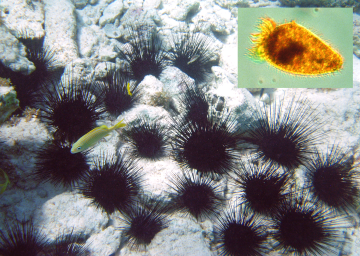SATS print 219_360 px width.png

A ciliate (similar to the one in the inset) caused a die-off of long-spined sea urchins in the Caribbean Sea. Urchin credit: Miranda Manross, CC BY 2.0. Ciliate credit: Cammie Hyatt, University of Texas Marine Science Institute.
In the middle of the COVID-19 pandemic, another epidemic began under the waves of the Caribbean Sea, extending from the coast of Florida to the northern coast of Venezuela. Starting in January 2022, long-spined sea urchins began losing their spines and dying off by the thousands. This species had already nearly disappeared during a massive die-off in 1983-84, when the population fell by about 98%. Scientists never figured out why the die-off happened, but the event had dire consequences, since these sea urchins eat algae that otherwise grow out of control and destroy corals. The 1980s die-off devastated nearby reefs, so when urchins started suddenly dying again, biologists were anxious to find out why.
A year later, the world has an answer to the mysterious case of the Caribbean urchin killer: the culprit is a single-celled animal called a ciliate, a protozoan named for the tiny hair-like structures, called cilia, they use for swimming. Conditions were likely ideal for these ciliates to reproduce in large numbers and then disperse throughout the Caribbean where they infected the sea urchins. The mystery was solved by the efforts of an international team of biologists from many universities and organizations throughout the Caribbean and led by a professor at the University of South Florida.
Thanks to the collaborative approach of these disease detectives, the forensic marine investigation took only four months, instead of the years it might normally take. They collected urchins from 23 sites throughout the Caribbean and performed various tests that pointed to the ciliate. Although most ciliates don’t cause disease, this particular one had already been known to kill other marine species, including sharks. Knowing the answer, however, has led to plenty of new questions, including how to prevent future similar events. But now, scientists have a place to start.


